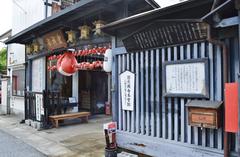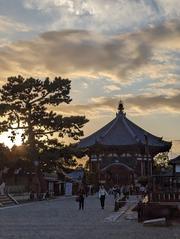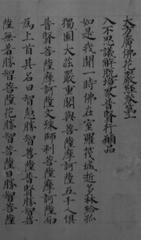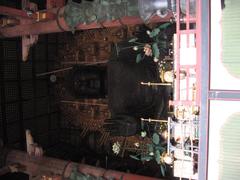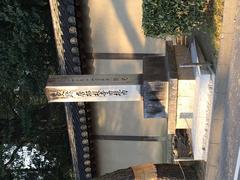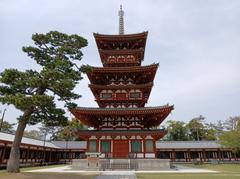
Daian-ji Nara Japan: Visiting Hours, Tickets, and Historical Sites Guide
Date: 03/07/2025
Introduction to Daian-ji Temple in Nara
Nestled in Nara, Japan’s ancient capital, Daian-ji stands as a remarkable monument to the country’s early Buddhist heritage and imperial patronage. Founded in the 7th century, Daian-ji is one of the Seven Great Temples (Nanto Shichi Daiji) and has significantly shaped Japan’s religious, cultural, and architectural history. Its origins, closely linked with imperial endorsement during the Nara period, mark it as a significant center for Buddhist learning and international exchange.
Today, Daian-ji’s tranquil grounds, although more modest than in its heyday, still echo the grandeur of its original Tang dynasty-inspired layout. Visitors can admire the intricately crafted main hall, home to the revered Yakushi Nyorai statue, and explore the evocative stone foundations of the temple’s lost pagodas. Daian-ji remains an active site of worship, inviting guests to experience its peaceful gardens, seasonal festivals, and scholarly heritage. This guide provides comprehensive details on visiting hours, ticketing, accessibility, and travel tips to help you make the most of your visit. For further planning, consult the Nara Official Travel Guide and Japan Guide.
Table of Contents
- Introduction
- Origins and Early Development
- Daian-ji Among the Seven Great Temples of Nara
- Architectural and Artistic Heritage
- Religious and Cultural Influence
- Visitor Information
- Decline and Preservation
- Daian-ji in the Modern Era
- Frequently Asked Questions (FAQ)
- Conclusion and Call to Action
- Related Articles
- Visuals and Media
Origins and Early Development
Daian-ji’s roots reach back to the earliest days of Japanese Buddhism. Originally established as Kudara-ō-ji in the 6th century under Emperor Kinmei, it represented the first imperial endorsement of Buddhism in Japan (Nara National Museum). The temple was later moved and renamed Daikan Daiji, and subsequently Daian-ji, as it expanded its influence. By the time the capital moved to Heijō-kyō (present-day Nara) in 710, Daian-ji had become a central institution, reflecting the deep ties between Buddhism and the state (taleofgenji.org).
Daian-ji Among the Seven Great Temples of Nara
As one of the Nanto Shichi Daiji, Daian-ji played a pivotal role in the Nara period’s religious, cultural, and political life (Nara National Museum). The temple was both a spiritual center and a hub of scholarship, attracting nearly a thousand priests, Japanese and foreign alike. Many of these monks went on to hold influential positions, helping to spread Buddhist teachings and practices throughout Japan.
Architectural and Artistic Heritage
At its zenith, Daian-ji was a marvel of early Japanese Buddhist architecture, with expansive grounds, grand halls, and twin seven-story pagodas (taleofgenji.org). Although fires, earthquakes, and social changes have reduced the original complex, archaeological studies and historical records capture its scale and artistry. The main hall (Kondō), rebuilt during the Edo period, features traditional irimoya-zukuri architecture and houses Important Cultural Properties, including the principal Yakushi Nyorai statue (Nara Prefecture Tourism).
Other notable features include the visible stone bases of the original pagodas, the lecture hall (Kōdō) for monastic study, and the main gate (Sanmon) adorned with guardian Nio statues (Nara City Tourism).
Religious and Cultural Influence
Daian-ji was instrumental in translating and copying Buddhist scriptures, fostering literacy and learning (Nara Prefecture Cultural Resources). Its international community of monks—especially from China and Korea—enriched its spiritual and intellectual life, making it a melting pot of Buddhist thought and practice.
Visitor Information
Visiting Hours
- Open: Daily, 9:00 AM – 5:00 PM
- Last Admission: 4:30 PM
- Note: Hours may vary during holidays or special events; check the official website for updates.
Tickets and Admission
- General Admission: Typically ¥400–¥600 for adults, with discounts for children and seniors (Trip.com)
- Special Exhibitions/Tours: Additional fees may apply
Accessibility & Getting There
- Location: About 2 km west of central Nara
- Access: Local bus or taxi from Nara Station (JR or Kintetsu), or a 10–15 minute ride
- On Foot: Approximately 3 km from Nara Park, through quiet neighborhoods (Adequate Travel)
- Accessibility: Mostly flat and wheelchair-friendly; some gravel or stone paths may require caution
Nearby Attractions
- Kofuku-ji: Famed for its five-story pagoda
- Todai-ji: Home to the Great Buddha (Daibutsu)
- Kasuga Taisha Shrine: Renowned for stone lanterns and ancient forest approach
- Nara Park: Iconic for its free-roaming deer (Nomadasaurus)
Guided Tours & Events
- Tours: Available in English and Japanese, often during special events
- Events: Seasonal festivals, lantern ceremonies, and Buddhist memorial services—check schedules in advance
Photographic Spots
- Best Times: Cherry blossom season (late March–April) and autumn foliage (November)
- Notes: Photography allowed outdoors; indoor restrictions may apply—respect posted signs
Decline and Preservation
Despite its early prominence, Daian-ji suffered from fires, natural disasters, and shifting political priorities, leading to the loss of many original structures. However, it remains a testament to Nara’s Buddhist heritage, with ongoing preservation and archaeological work ensuring its legacy (Nara National Museum).
Daian-ji in the Modern Era
Today, Daian-ji serves as both an active temple and a historical site, welcoming worshippers and travelers alike. Exhibitions at the Nara National Museum and other cultural centers highlight its enduring contributions to Japanese art, religion, and architecture (Nara National Museum).
Frequently Asked Questions (FAQ)
Q: What are Daian-ji’s opening hours?
A: 9:00 AM to 5:00 PM daily; last entry 30 minutes before closing.
Q: How much is admission?
A: Typically ¥400–¥600 for adults; discounts for children and seniors.
Q: Is Daian-ji wheelchair accessible?
A: Most areas are accessible, though some gravel paths may be challenging.
Q: Can I take photographs inside the temple?
A: Photography is allowed outdoors but may be restricted inside the main hall.
Q: Are guided tours available?
A: Yes, especially during special events or by arrangement—ask at the temple or local tourism offices.
Q: How do I reach Daian-ji from Nara Station?
A: By local bus or taxi in about 10–15 minutes; walking from Nara Park takes 30–40 minutes.
Conclusion and Call to Action
Daian-ji stands as a vital cultural and spiritual landmark in Nara, offering visitors a unique window into Japan’s Buddhist heritage. Its blend of history, tranquil gardens, and accessible facilities creates a memorable experience for all. For an enriched visit, check the latest updates on official tourism sites and consider using the Audiala app for guided tours and exclusive content.
Plan your journey today, explore other historic sites in Nara, and share your experiences to inspire fellow travelers!
Related Articles
Visuals and Media
- Optimized images of Daian-ji with alt text: “Daian-ji temple Nara historical site.”
- Interactive map showing Daian-ji’s location.
- Links to virtual tours via Nara Official Travel Guide.
Summary and Further Exploration
Daian-ji encapsulates centuries of Japanese Buddhist history, architecture, and religious practice. Its preservation, ongoing worship, and cultural events make it a living monument. Visitors can enjoy serene gardens, sacred art, and a sense of tranquility away from the city’s busier attractions. For more information, consult the Nara National Museum and Trip.com.
References and Further Reading
- Nara National Museum – Daian-ji Special Exhibition
- Japan Guide – Daian-ji Temple
- Trip.com – Daian-ji Temple
- Nara Official Travel Guide – Daian-ji
- Nara Prefecture Cultural Resources
- Nara Prefecture Tourism – Daian-ji




















